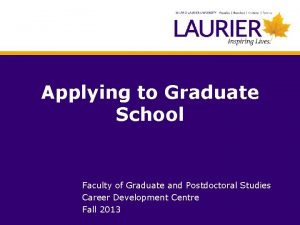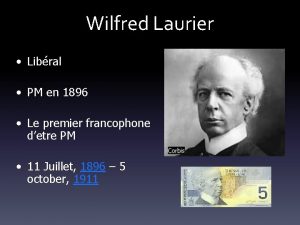Canadians Choose a New Government Wilfred Laurier died





- Slides: 5

Canadians Choose a New Government • Wilfred Laurier died in 1919. To choose a new leader, the Liberal Party held the country's first ever leadership Convention. William Lyon Mackenzie King defeated W. S. Fielding to become the new leader of the Liberal Party. • At the Convention, the adopted new policies: • They approved the principle of proportional representation • They supported a general reduction of the tariff • They proposed the enactment of schemes of insurance against unemployment, sickness, old age, and disability • The Liberals would enter the 1921 election guided by King's leadership philosophy – that a leader should bring opposing views together to work towards a common goal. King saw himself as a referee between diverse interests, rather than as the final word on all party decisions.

Robert Borden is the 8 th prime minister he served as prime minister from June 26, 1854 – June 10, 1937.

• Regionalism and the progressive party greatly influenced the results of the 1921 federal election , effectively upsetting the balance of power between the Liberals and the Conservatives. • In the 1921 federal election , both the Liberals and the Conservatives had new leaders. • William Lyon Mackenzie was chosen to lead the Liberals in 1919.

To be continued…. . • • • • Canada is one of the largest countries in the world. Its six time zones pose a challenge for administering elections. There will be 338 federal electoral districts (also called "ridings" or constituencies) in Canada for the 42 nd federal general election. Since 1997, Elections Canada has maintained a National Register of Electors that includes, in 2011, over 23 million electors. According to the 2001 census, federal electoral districts each have an average of 70, 954 electors. Each year, about 15% of the Canadian population moves, slightly over 1% turns 18 and acquires the right to vote, 1% acquires citizenship, and 1% passes away. The Canadian Charter of Rights and Freedoms states that "Every citizen of Canada has the right to vote in an election of members of the House of Commons or of a legislative assembly and to be qualified for membership therein. " The Canada Elections Act further states that "Every person who is a Canadian citizen and is 18 years of age or older on polling day is qualified as an elector. " The Canadian Charter of Rights and Freedoms states that "No House of Commons and no legislative assembly shall continue for longer than five years from the date fixed for the return of the writs of a general election of its members. " Longer terms are possible only in cases of real or apprehended war, invasion or insurrection, and must be endorsed by at least two thirds of the members of the House of Commons or the legislative assembly, as the case may be. Canadian federal elections and the right to vote: historical milestones 1874 - The secrecy of the vote was introduced with the adoption of paper ballots and voting booths 1918 - Women were enfranchised at the federal level 1919 - Women obtained the right to run as candidates in federal elections 1920 - The position of Chief Electoral Officer of Canada was created to oversee the administration of federal elections nationwide 1921 - In the 1921 general election, Agnes Macphail became the first woman elected to Parliament










